As summer fades away and the air becomes crisp, nature puts on a breathtaking display of colors. The vibrant reds, oranges, and yellows that adorn the trees during fall are not just visually pleasing; they hold great importance in our lives. Fall colors have a way of captivating our senses and evoking emotions.
These striking hues serve an important purpose in nature. The bright pigments act as a protective shield for leaves as they prepare for winter dormancy. Additionally, fall colors play a crucial role in ecosystems by attracting pollinators like bees and butterflies. As these insects gather nectar from flowers amidst colorful surroundings, they inadvertently aid in plant reproduction through pollen transfer.
14 Best Trees for Fall Colors
Maple Trees: A Colorful Fall Display
Regarding autumn colors, maple trees steal the show with their vibrant and eye-catching display. These majestic trees are known for their stunning foliage that turns different shades of red, orange, and yellow as the season transitions. As the temperature drops and daylight decreases, these beautiful leaves put on a show like no other. The beauty of maple trees in fall goes beyond aesthetics; it symbolizes change and transformation. It serves as a reminder that even though things may change around us, there is still incredible beauty to behold.
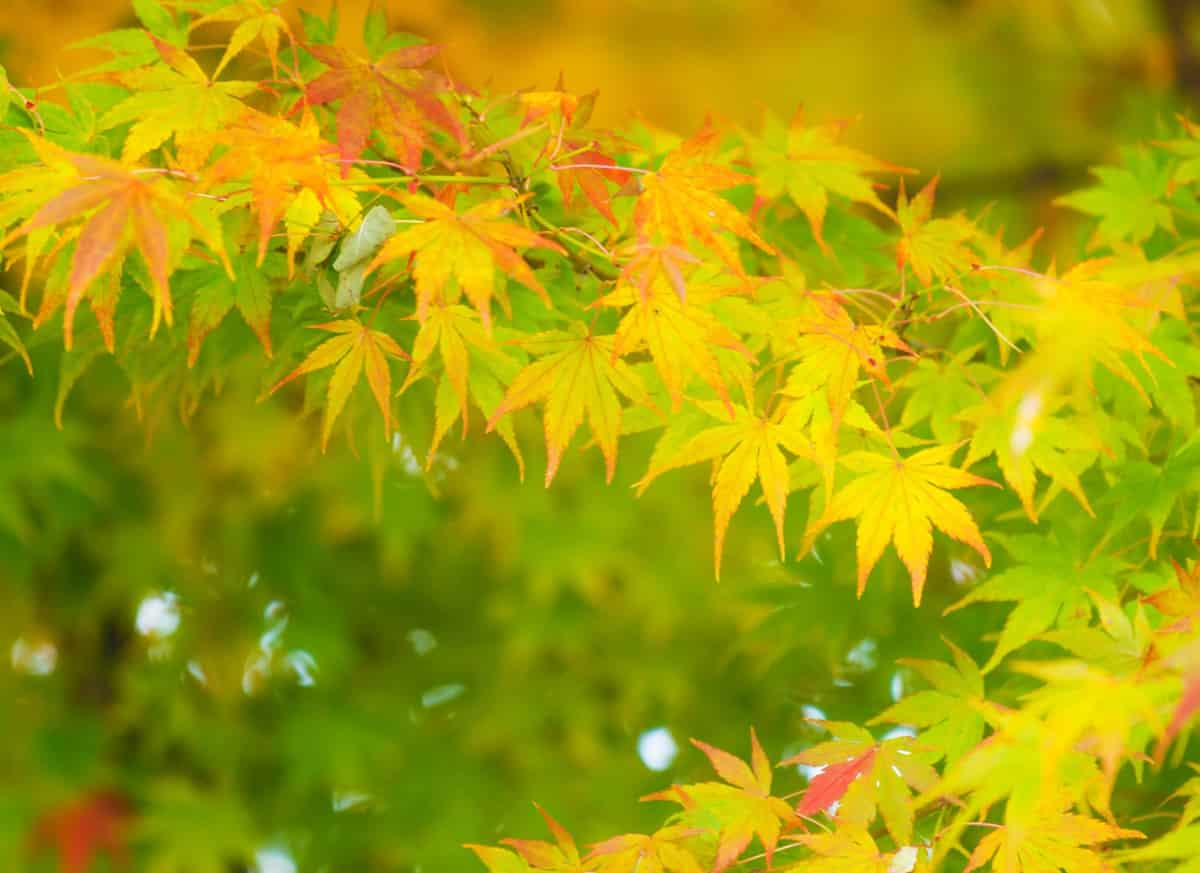
Tupelo Trees: Spectacular Autumn Reds
Tupelo trees are renowned for their stunning display of autumn colors. As the temperatures cool and summer fades away, these magnificent trees transform into a vibrant spectacle of reds that will leave you in awe. The leaves of the tupelo tree turn various shades of red during the fall season. From deep crimson to fiery scarlet, the foliage creates a breathtaking contrast against the clear blue sky or grey overcast days. It’s like nature is showcasing its version of an artist’s palette.
What makes Tupelo trees even more special is their ability to produce different hues within one single tree. Some branches may have leaves that turn a rich burgundy color, while others display shades of bright orange red. This dynamic range adds depth and complexity to their overall appearance. Walking through a forest adorned with tupelo trees in full autumn glory feels like stepping into a painting to come to life. The vibrant red hues create an atmosphere filled with warmth and beauty. It’s no wonder many people seek out these spectacular displays yearly.
Oak Trees: Majestic Autumn Foliage
Oak trees are iconic symbols of strength and resilience, standing tall and proud in forests worldwide. In autumn, these majestic giants transform into breathtaking colors that rival even the most vibrant paintings. The leaves of oak trees turn shades of deep red, burnt orange, golden yellow, and rich brown, creating a warm and inviting atmosphere. As the days grow shorter and cooler, the foliage of oak trees begins to change. The green leaves gradually transition into fiery hues that captivate our senses.
In case you missed it: The Best Plants for USDA Zone 9: Top Trees, Flowering, Perennial, Drought-Tolerant, and Container Plants
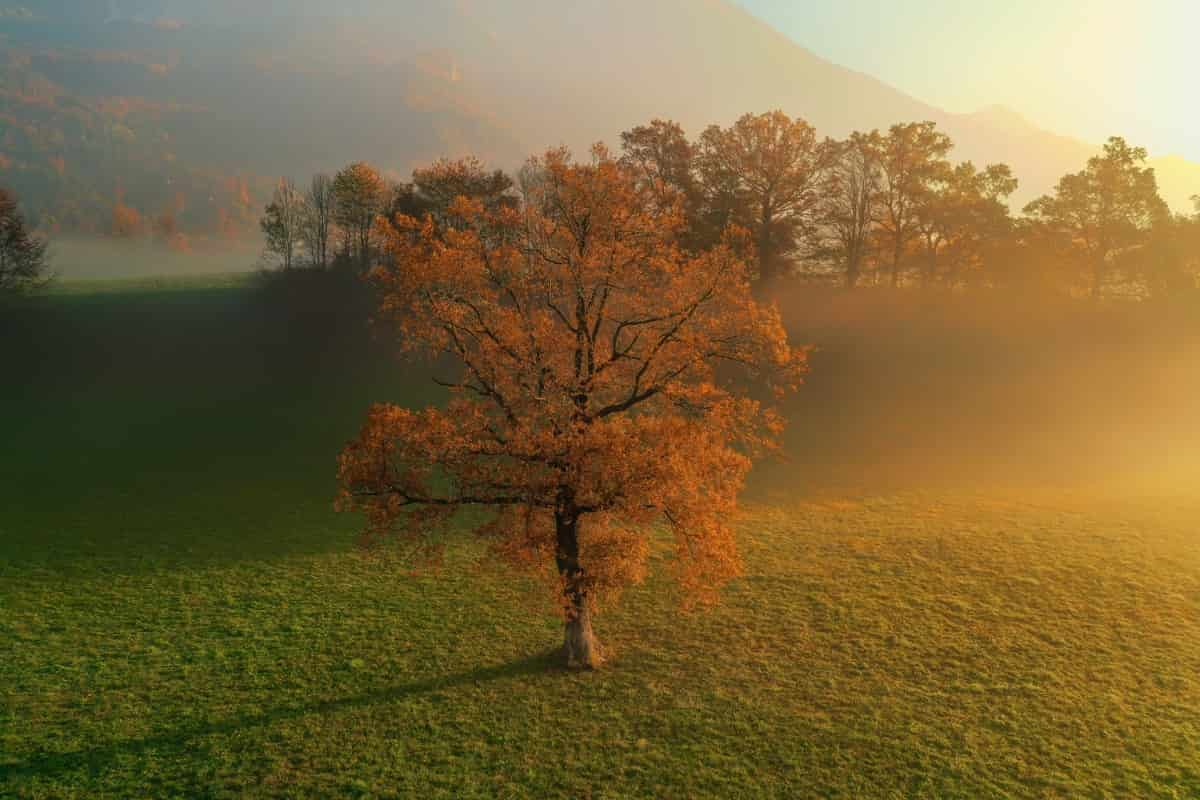
Walking through a forest filled with oak trees during fall feels like stepping into a magical realm where nature is putting on its grandest show. The beauty of oak tree foliage lies not only in its vibrant colors but also in its longevity. Unlike other trees whose leaves quickly fade after changing color, oak tree leaves tend to linger on branches well into winter. This means you can enjoy their stunning autumn foliage for an extended period.
Sumac Trees: Vibrant Fall Foliage
Sumac trees are known for their vibrant fall foliage, adding color to any landscape. With their stunning red, orange, and yellow leaves, these trees create a breathtaking display during the autumn season. One of the most striking features of sumac trees is their ability to turn bright shades of red. As the temperatures drop and daylight hours shorten, the leaves transform, rivaling even the fieriest sunsets. The rich crimson hues stand out against the backdrop of other trees in your yard or along roadsides.
In addition to its brilliant red tones, sumac also offers variations in color with its yellow and orange foliage. This dynamic range makes it a standout choice for those seeking diversity in their fall landscape. Its unique growth habit sets Sumac apart from other fall foliage trees. Unlike many tall and straight-trunked species, sumacs often grow as shrubs or small-sized trees with multiple trunks branching out from near ground level. This creates an interesting visual effect when combined with its eye-catching colors.
Birch Trees: Delicate Beauty in Autumn
Birch trees add beauty to any landscape with slender trunks and delicate leaves. In the fall, these graceful trees transform into stunning displays of color that captivate the eye. As autumn sets in, the leaves of birch trees turn vibrant shades of yellow, gold, and even hints of orange. Against a backdrop of clear blue skies or gray clouds, these warm hues create an enchanting scene that is hard to resist. The contrast between the pale bark and the colorful foliage further enhances the beauty of birch trees in autumn. It’s like nature’s own work of art unfolding before our eyes.
In case you missed it: Top 14 Fast-Growing Fruit Trees
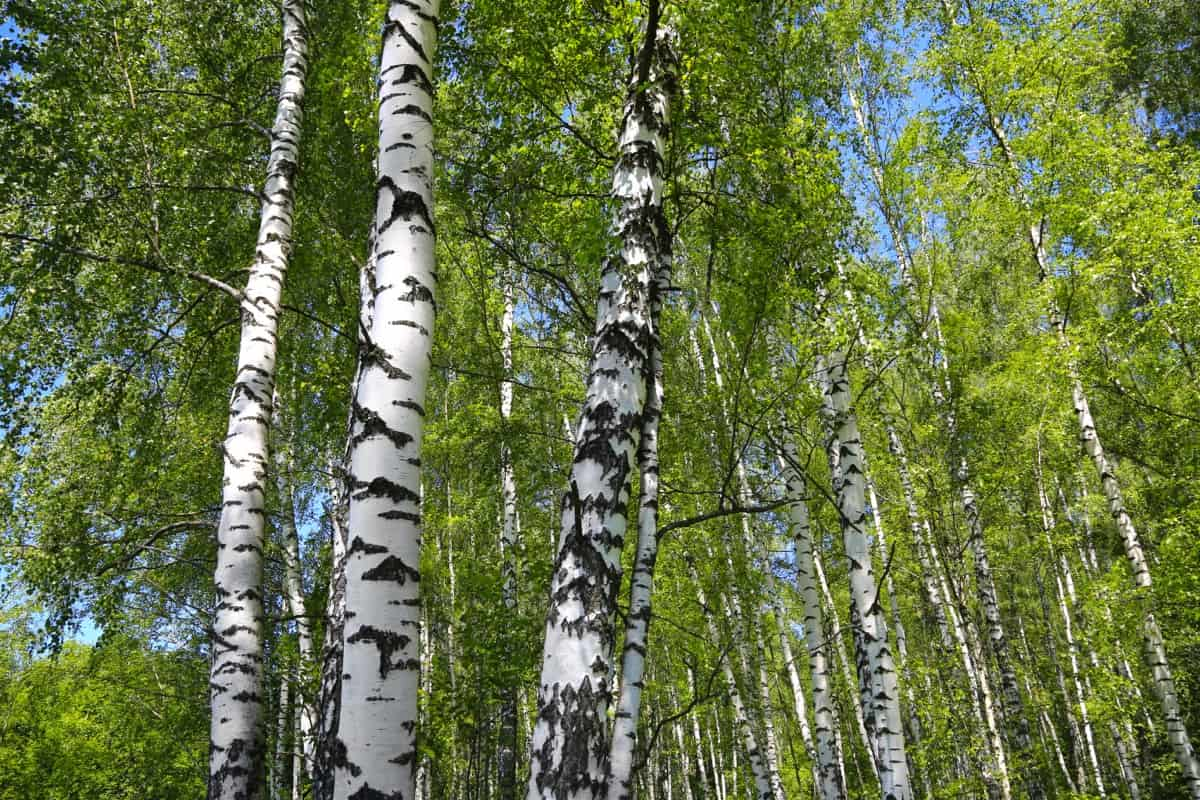
Beech Trees: Warm Tones for Fall
Beech trees, with their warm and inviting hues, are a sight to behold during the fall season. As the leaves transition from vibrant greens to rich shades of gold and copper, these majestic trees add an enchanting touch to any landscape. The beech tree’s foliage is known for its smooth texture and glossy appearance. This beauty is enhanced in autumn as the leaves transform into a palette of warm tones ranging from golden yellows to fiery oranges. It’s like nature’s own painting unfolding before our eyes.
One of the remarkable things about beech trees is their ability to retain their leaves well into winter. This means that even after other trees have shed their foliage, beeches continue to provide a splash of color against a backdrop of gray skies and bare branches. Not only do beech trees offer stunning colors in autumn, but they also provide shade and shelter throughout the year. Their dense canopy creates a cozy atmosphere beneath them where one can take refuge from the sun and rain.
Liquidambar Trees: Fiery Fall Foliage
Liquidambar trees are renowned for their fiery fall foliage. As the temperatures drop and summer gives way to autumn, these majestic trees put on a stunning display of vibrant colors that light up the landscape. One of the unique features of liquidambar trees is their ability to produce leaves in a wide range of hues.
The leaves themselves are quite distinctive, with five pointed lobes resembling stars. As they change color in the fall, they transform into small works of art that add beauty to any garden or park. But not just their appearance makes liquidambar trees stand out during this season. In addition to their visual appeal and auditory charm, liquidambar trees also emit a pleasant fragrance when their leaves start falling. The scent is often described as spicy or resinous—a delightful bonus for those who appreciate sensory experiences.
Dogwood Trees: Vibrant Fall Colors
Dogwood trees are renowned for their vibrant fall colors, adding beauty to any landscape during autumn. These magnificent trees offer a stunning display of hues that range from deep reds and oranges to bright yellows. As the leaves change color, they create an enchanting scenery that captures the season’s essence. The dogwood’s ability to provide such vibrant fall colors stems from its pigments known as anthocyanins.
In case you missed it: Top 19 Best Fast-Growing Trees to Plant in Your Garden
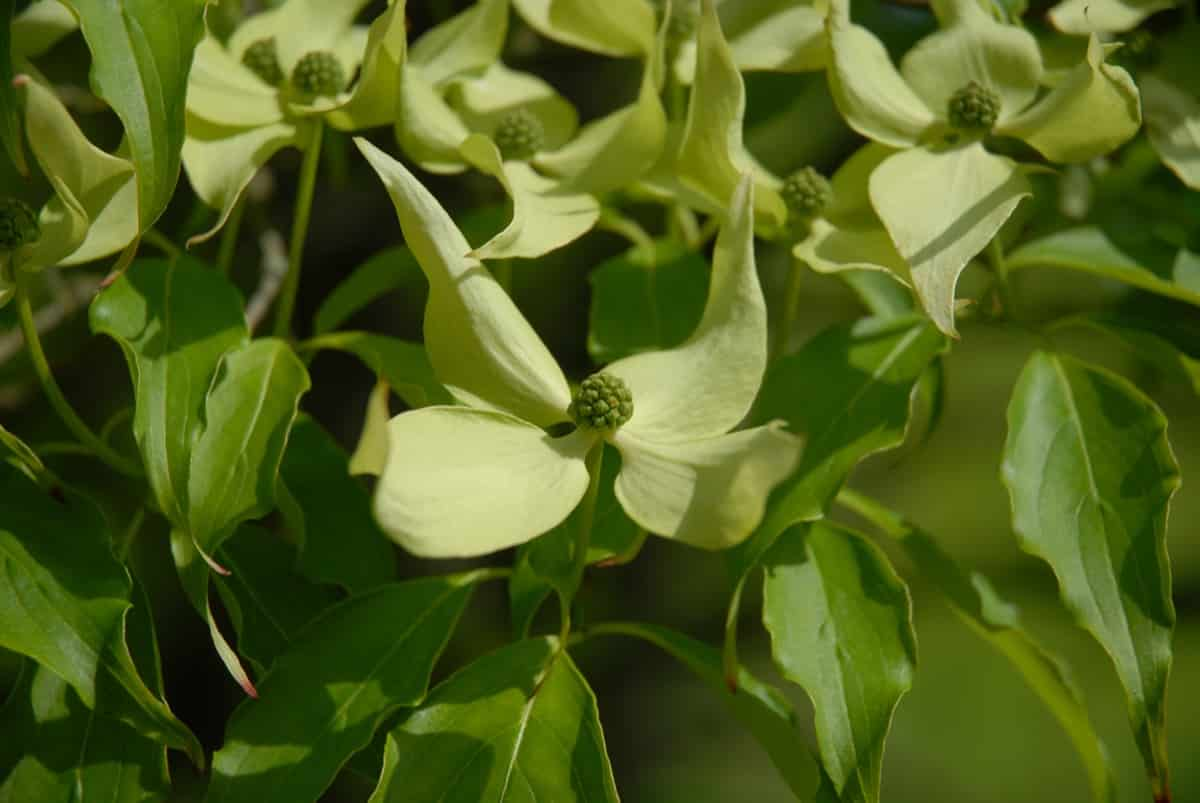
These compounds produce intense reds and contribute to other warm tones like orange and yellow. In addition to their vivid autumn foliage, dogwoods also produce ornamental fruit called drupes, which add further visual interest during this time of year. These small berries come in various shades, including bright red and glossy black, attracting birds who feed on them while enhancing the overall appeal of these trees.
Redbud Trees: Stunning Fall Coloration
One of the excellent choices for adding color to fall landscape is the redbud tree. With its vibrant fall foliage, this tree will surely catch the eye and bring beauty to any outdoor space. Redbuds transform from their usual green leaves into a stunning array of reds and oranges in the fall months. The colors are so striking that they almost seem painted on. As the leaves change hue, they create a captivating contrast against the clear blue sky or even against other trees in your yard.
The unique heart-shaped leaves of the Redbud add another layer of visual interest to its already stunning fall display. They dance in the crisp autumn breeze and create a whimsical atmosphere that is hard to resist. Not only do Redbuds offer gorgeous colors of fall, but they also provide shade throughout spring and summer with their small flowers that bloom before leafing out.
Sassafras Trees: Multicolored Autumn Leaves
Sassafras trees are a true delight to behold in the fall season. With their multicolored autumn leaves, they bring a vibrant burst of color to any landscape. From rich oranges and fiery reds to deep purples and sunny yellows, the foliage of the sassafras tree is truly mesmerizing. The changing colors of the sassafras leaves can be attributed to pigments called anthocyanins.
These pigments are responsible for creating those beautiful shades we see in nature during autumn. As temperatures cool, chlorophyll production slows, and other pigments like anthocyanins become more prominent. Not only do sassafra trees provide visual beauty during fall, but they also have a lovely fragrance when their leaves are crushed or bruised.
Sweetgum Trees: Brilliant Autumn Leaves
Sweetgum trees are renowned for their brilliant autumn leaves. These majestic trees display a stunning array of colors that can transform any landscape into a vibrant and breathtaking scene. In the fall, Sweetgums showcases a kaleidoscope of hues ranging from deep burgundy and fiery red to bright orange and golden yellow. The leaves seem to catch fire under the warm sunlight, creating an enchanting spectacle for all to admire. What makes Sweetgum trees truly unique is their star-shaped foliage.
In case you missed it: Top 14 Dwarf Evergreen Trees for Your Garden
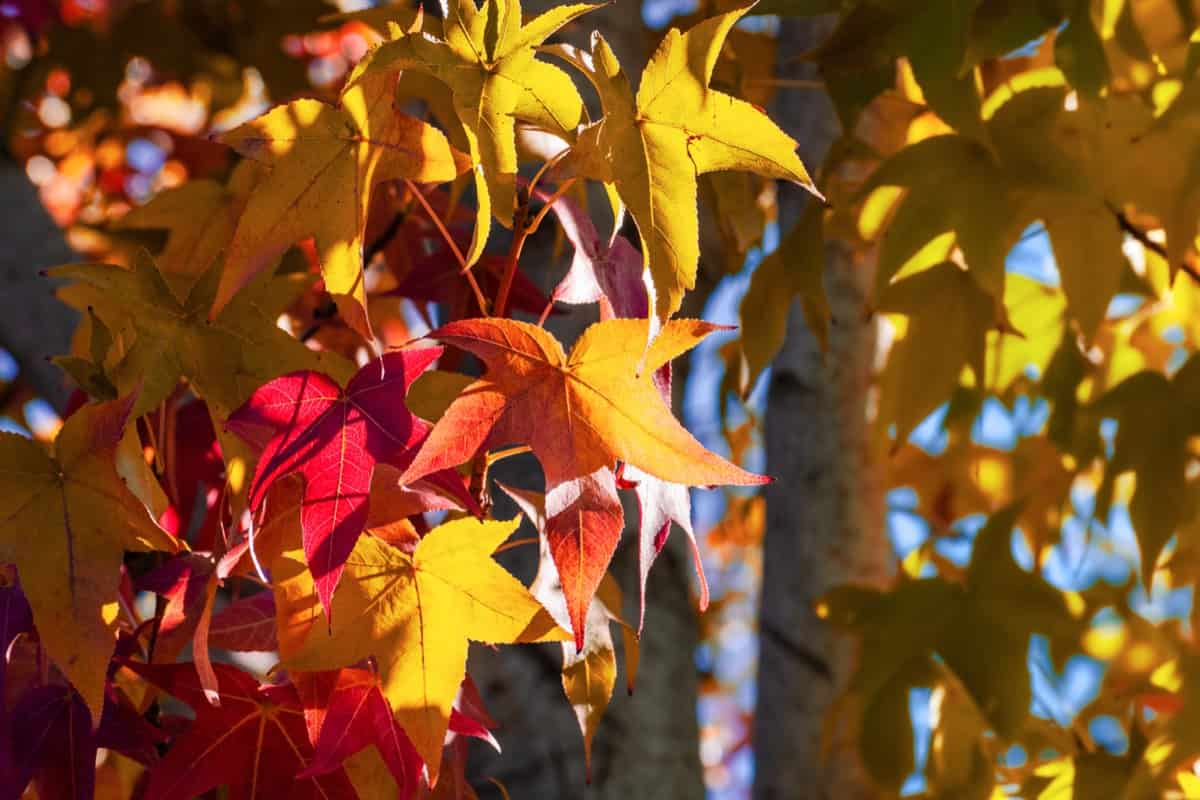
Each leaf bears five to seven pointed lobes that add elegance to its striking appearance. The leaves dance gracefully as the wind rustles through the branches, painting the sky with their vivid palette. Not only are Sweetgums visually appealing in autumn, but they also provide shade and shelter throughout the year. Their sturdy trunks and sprawling branches create a perfect place for picnics or leisurely walks on crisp fall days. Whether planted individually as focal points or grouped to form colorful groves, Sweetgum trees never fail to captivate with their radiant autumn display.
Ginkgo Trees: Golden Fall Foliage
Ginkgo trees are renowned for their stunning golden fall foliage. The leaves of the ginkgo tree turn a vibrant shade of yellow that is unmatched by any other tree in the fall. They create a breathtaking canopy of gold, adding warmth and brightness to any landscape. The sight of ginkgo trees in full autumn glory is truly awe-inspiring.
Not only are ginkgo leaves beautiful, but they also have an interesting fan-like shape that adds to their appeal. As they flutter down from the branches and blanket the ground below, it’s like walking on a carpet made entirely of gold. Whether you plant one in your backyard or stumble upon one while strolling through your neighborhood park, encountering a ginkgo tree during fall will surely leave you captivated by its radiant golden foliage.
Hickory Trees: Rustic Fall Hues
Hickory trees, with their rustic fall hues, are a beautiful addition to any landscape during the autumn season. These majestic trees boast leaves that turn shades of yellow, orange, and brown, creating a warm and inviting atmosphere. As the temperatures begin to cool, hickory trees start their transformation. The vibrant green leaves gradually shift into stunning shades of gold and amber.
Walking through an area filled with hickory trees in fall is like stepping into a painting – each tree displaying its unique blend of colors. The foliage of hickory trees adds depth and texture to the landscape as it transitions from lush green to rich autumn hues. Against a backdrop of other deciduous trees also changing color, such as maples and oaks, hickories stand out for their distinctively rustic tones. Not only do hickory trees provide visual appeal in the fall season, but they also offer practical benefits.
Aspen Trees: Quaking Gold in Autumn
Aspen trees, with their shimmering gold leaves, are a true spectacle in the fall. These majestic trees create a breathtaking display that is both beautiful and captivating. One of the most distinctive features of aspen trees is their quaking leaves. The leaves flutter and tremble as the wind blows through their branches, creating a mesmerizing effect that adds even more charm to their golden hues.
In case you missed it: How to Control Pests and Diseases in Apple Trees: Causes, Symptoms, Chemical, and Biological Management
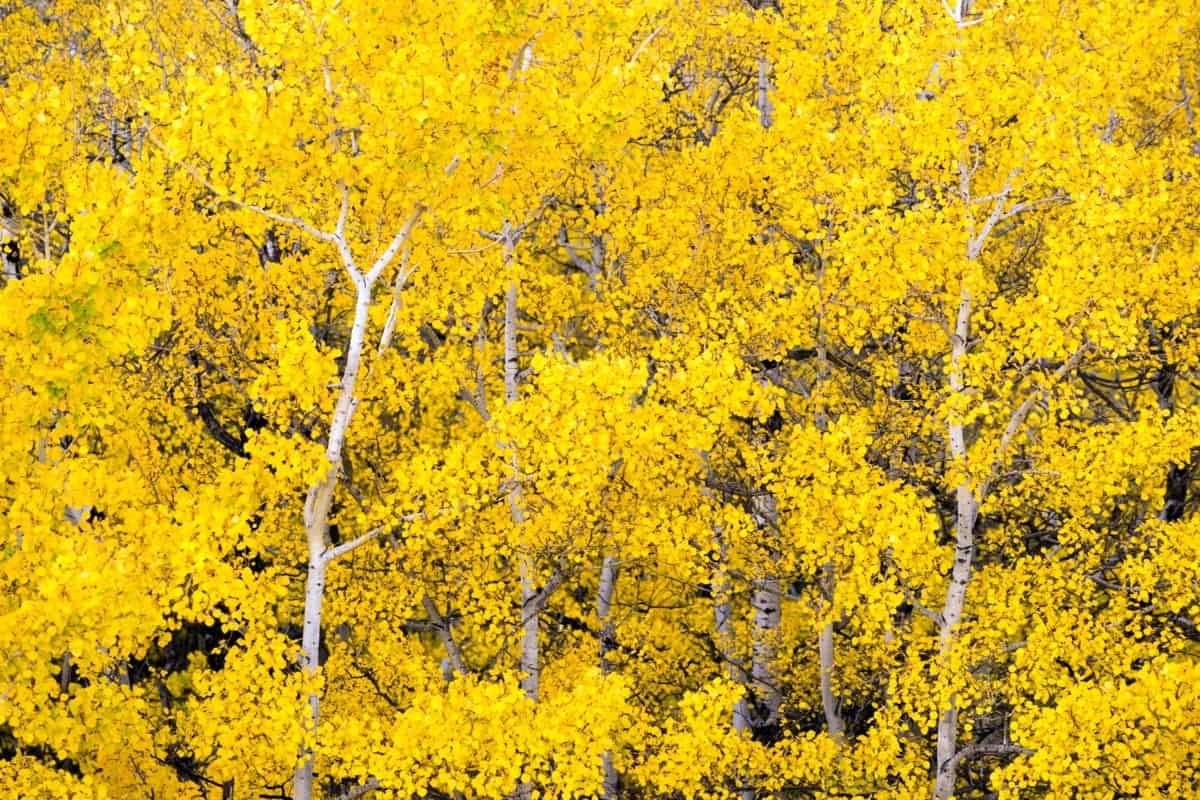
The vibrant colors of aspen trees in autumn can transform any landscape into a scene straight out of a painting. Their bright yellow foliage stands out against evergreen pines and deep blue skies, creating a striking, stunning contrast. Not only do aspens provide visual beauty during this season, but they also bring tranquility. The rustling sound made by their trembling leaves creates an immersive auditory experience that enhances the overall ambiance of the fall.
Conclusion
No matter which tree you choose, be sure to provide proper care and maintenance throughout the year so they can continue delighting you with their beautiful fall colors season after season. And don’t forget to take some time this autumn to admire nature’s breathtaking display as these magnificent trees transform into kaleidoscopes of color.
- Cabbage Seed Germination and Selection
- Broccoli Seed Germination and Selection
- Asparagus Seed Germination and Variety Selection
- Seasonal Flower Gardening: Best Practices for Spring, Summer, Fall, and Winter
- How to Grow Hibiscus from Flower
- Plantation Ideas for Home Decoration: A Beginners Guide
- Flower Garden Designs and Layouts for Beginners
- Planting and Spacing Techniques in Papaya: A Beginner’s Guide
- Growing Gold: Essential Techniques for Planting Pineapples
- How to Make Kalanchoe Plant Bushy: Home Remedies and Solutions
- 11 Reasons Why Your Gardenia is Not Blooming: Home Remedies and Solutions
- Eco Elegance: The Guide to Designing a Drought-Tolerant Landscape
- Gardening on a Slope: Strategies for Hillside Landscaping
- Nourish and Flourish: Top Organic Mulches for Thriving House Plants
- Everything You Want to Know about Indian Mogra Flower: Discover Uses and Growing
- Green Thumb Success: Expert Tips for Cultivating Greenhouse Pumpkins All Year Round
- Maximize Growth & Flavor: The Ultimate Guide to Companion Planting in Herb Gardens
- How to Control Rhododendron Problems Naturally: Home Remedies and Organic Ways to Fix Them
- Natural Magic: The Remarkable Benefits of Cinnamon for Plants
- Best Steps to Revive Dying Tulip with Natural and Organic Treatment
- 10 Reasons Why Your Angel Trumpet is Not Blooming: Remedies and Treatment
- How to Fix Periwinkle Leaf and Flower-Related Problems: Natural Remedies and Solutions
- How to Fix Zinnias Leaf and Flower Problems: Discover Natural and Home Remedies
- Organic Steps to Induce Lemon Tree Flowers: A Comprehensive Guide
- Bloom Booster: Crafting the Perfect Homemade Bougainvillea Fertilizer
- Optimizing Growth: A Guide to Applying NPK Fertilizer for Potted Plants
- 10 Best Homemade Fertilizers for Rubber Plant: DIY Recipes and Application Method
- How to Boost Female Pumpkin Flowers: Effective Steps for More Flowers and High Yields
- Transform Your Indoor Garden: Top Benefits of Pink Salt for Houseplants
- 10 Best Homemade Fertilizers for Peacock Plants (Calathea): Easy DIY Guide
- Unlock Blooms: 9 Reasons Why Your Potted Chrysanthemum is Not Blooming
- 8 Reasons Why Your Potted Hibiscus is Not Blooming: Fix it with Simple Solutions
- Unlock Blooms: 9 Key Reasons Your Potted Frangipani Won’t Flower
- 10 Reasons Why Is My Ice Plant Not Blooming: Remedies and Treatment
- 10 Reasons Why My Potted Hydrangea Not Blooming: Treatment and Remedies
- 10 Reasons Why is My Wisteria Not Blooming: Remedies and Treatment